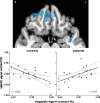Failure to regulate: counterproductive recruitment of top-down prefrontal-subcortical circuitry in major depression
- PMID: 17699669
- PMCID: PMC6672169
- DOI: 10.1523/JNEUROSCI.2063-07.2007
Failure to regulate: counterproductive recruitment of top-down prefrontal-subcortical circuitry in major depression
Abstract
Although depressed mood is a normal occurrence in response to adversity in all individuals, what distinguishes those who are vulnerable to major depressive disorder (MDD) is their inability to effectively regulate negative mood when it arises. Investigating the neural underpinnings of adaptive emotion regulation and the extent to which such processes are compromised in MDD may be helpful in understanding the pathophysiology of depression. We report results from a functional magnetic resonance imaging study demonstrating left-lateralized activation in the prefrontal cortex (PFC) when downregulating negative affect in nondepressed individuals, whereas depressed individuals showed bilateral PFC activation. Furthermore, during an effortful affective reappraisal task, nondepressed individuals showed an inverse relationship between activation in left ventrolateral PFC and the amygdala that is mediated by the ventromedial PFC (VMPFC). No such relationship was found for depressed individuals, who instead show a positive association between VMPFC and amygdala. Pupil dilation data suggest that those depressed patients who expend more effort to reappraise negative stimuli are characterized by accentuated activation in the amygdala, insula, and thalamus, whereas nondepressed individuals exhibit the opposite pattern. These findings indicate that a key feature underlying the pathophysiology of major depression is the counterproductive engagement of right prefrontal cortex and the lack of engagement of left lateral-ventromedial prefrontal circuitry important for the downregulation of amygdala responses to negative stimuli.
Figures





References
-
- Amaral DG, Price JL. Amygdalo-cortical projections in the monkey (Macaca fascicularis) J Comp Neurol. 1984;230:465–496. - PubMed
-
- Barbas H. Anatomic basis of cognitive-emotional interactions in the primate prefrontal cortex. Neurosci Biobehav Rev. 1995;19:499–510. - PubMed
-
- Beauregard M, Paquette V, Levesque J. Dysfunction in the neural circuitry of emotional self-regulation in major depressive disorder. NeuroReport. 2006;17:843–846. - PubMed
-
- Bernick N, Overlander M. Effect of verbalization and two different modes of experiencing on pupil size. Percept Psychophys. 1968;3:327–330.
-
- Brody AL, Saxena S, Mandelkern MA, Fairbanks LA, Ho ML, Baxter LR. Brain metabolic changes associated with symptom factor improvement in major depressive disorder. Biol Psychiatry. 2001;50:171–178. - PubMed
MeSH terms
Substances
LinkOut - more resources
Full Text Sources
Miscellaneous
